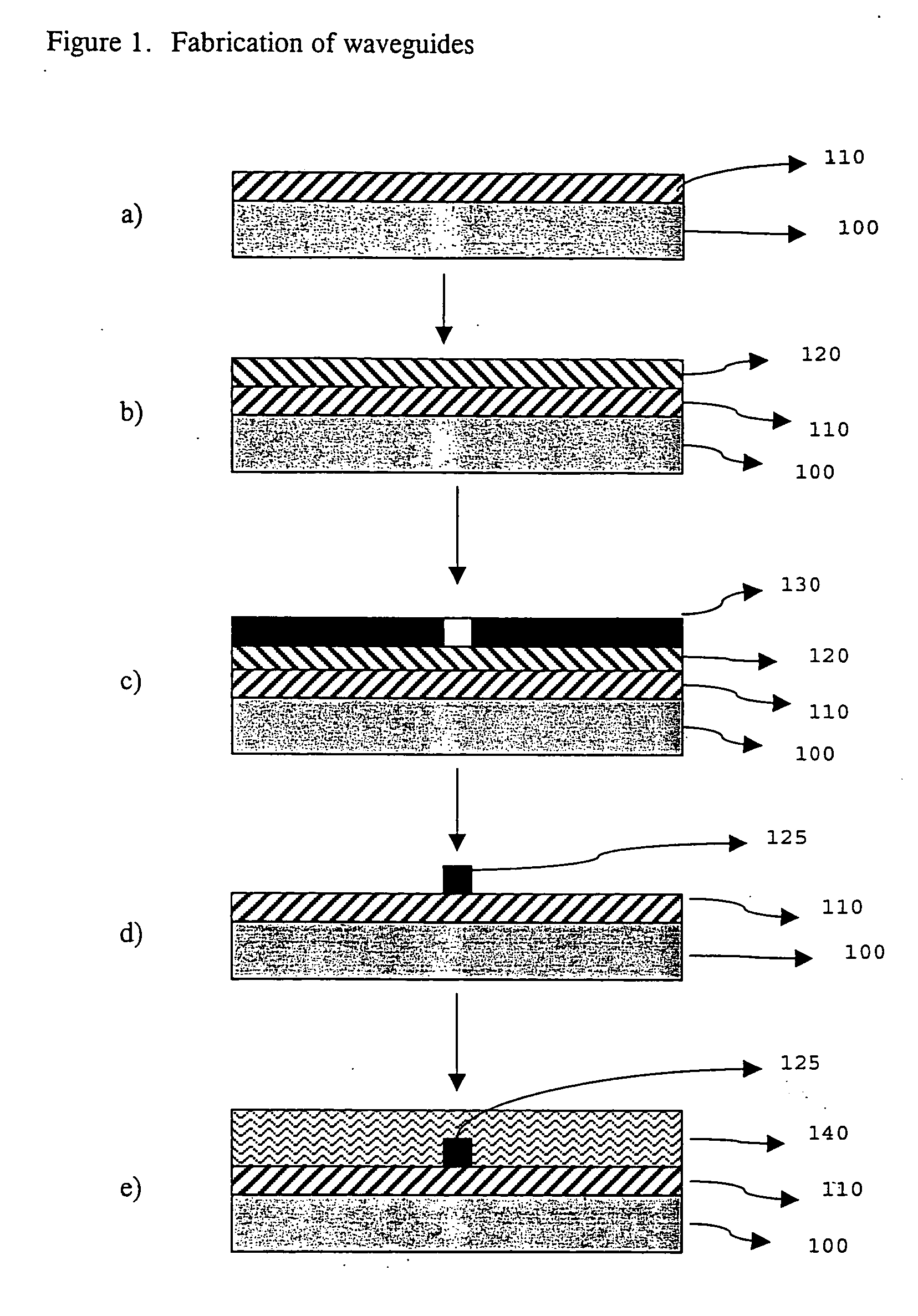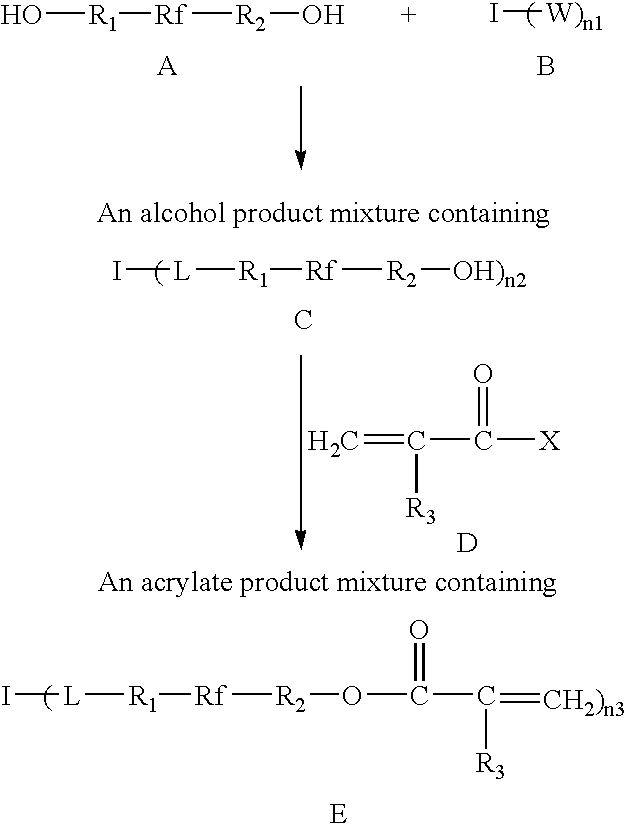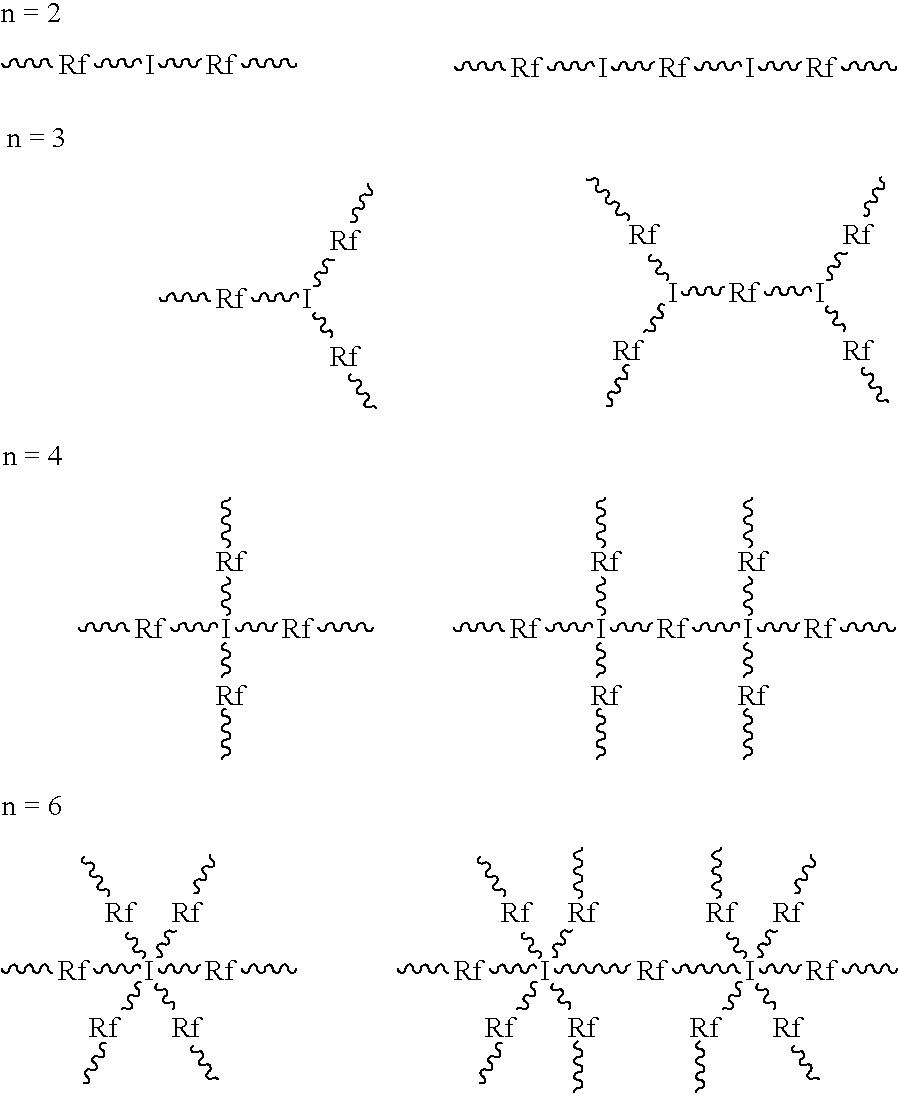Photosensitive acrylate composition and waveguide device
a technology of acrylate and composition, applied in the direction of photosensitive materials, instruments, photomechanical devices, etc., can solve the problems of high residual stress, high scattering loss, and device that does not meet all the requirements of practical use in telecommunication networks, and achieves high curing speed, controllable refractive index, and high photo contrast.
- Summary
- Abstract
- Description
- Claims
- Application Information
AI Technical Summary
Benefits of technology
Problems solved by technology
Method used
Image
Examples
example 1
[0055] One equivalent of 1,3,5-benzenetricarbonyl trichloride and 4.5 equivalents of 1H, 1H, 8H, 8H-perfluorotetraethyleneglycol were dissolved in anhydrous ether (0.2 M 1,3,5-benzenetricarbonyl trichloride solution) in a cooled, argon-inerted three-neck flask while stirring. The flask was cooled with an ice-water bath. To this reaction mixture was added dropwise 3 equivalents of anhydrous triethylamine. After addition of triethylamine the mixture was stirred 2 hours at room temperature. The mixture was filtered through Celite to remove salt. The filtrate was concentrated to remove ether solvent and then vacuum distilled at 90° C., 0.1 mmHg to remove the unreacted 1H, 1H, 8H, 8H-perfluorotetraethyleneglycol. A viscous fluorinated liquid alcohol was obtained.
example 2
[0056] The alcohol prepared in Example 1 and 200 ppm hydroquinone were mixed in anhydrous t-butylmethylether (at 0.5 M hydroxyl group) in an argon-inerted three neck flask. To this reaction mixture was added 1.2 equivalents of acryloyl chloride for each equivalent of hydroxyl group. Then 1.15 equivalents of anhydrous diisopropylethylamine was added dropwise with stirring. The reaction mixture was stirred for 10 h at room temperature. The reaction mixture was then quenched with 0.3 equivalent of methanol and stirred for 2 h to neutralize excess acryloyl chloride. The mixture was filtered through Celite / silica to remove salt. The filtrate solution was concentrated and pumped under vacuum at 60° C. to yield a liquid acrylate, F12C8-3S-A. The crude product was then treated with 2% activated activated carbon to remove a light yellow color. F12C8-3S-A has a refractive index nD23 of 1.384 and viscosity at 23° C. of 2200 cP.
example 3
[0057] One equivalent of 1,3,5-benzenetricarbonyl trichloride and 4.5 equivalents of Fluorolink D10, a fluorinated polyether diol commercially available from Ausimont USA, were dissolved in anhydrous t-butylmethylether (0.08 M 1,3,5-benzenetricarbonyl trichloride) in an argon-inerted three-neck flask with stirring in an ice-water bath. To the reaction mixture was added dropwise 3 equivalents of anhydrous diisopropylethylamine. After addition of the diisopropylethylamine the mixture was stirred for 2 hours at room temperature. Then 7.2 equivalents of acryloyl chloride were added to the stirred mixture, followed by 6.9 equivalents of anhydrous diisopropylethylamine. The reaction mixture was stirred for an additional 6h at 50° C. Finally the reaction mixture was quenched with 3.6 equivalents of methanol and stirred for 2 h to neutralize excess acryloyl chloride. The mixture was filtered through Celite / silica to remove salt. The filtrate solution was concentrated and pumped under vacuum...
PUM
| Property | Measurement | Unit |
|---|---|---|
| wavelength | aaaaa | aaaaa |
| shrinkage | aaaaa | aaaaa |
| wt % | aaaaa | aaaaa |
Abstract
Description
Claims
Application Information
 Login to View More
Login to View More - R&D
- Intellectual Property
- Life Sciences
- Materials
- Tech Scout
- Unparalleled Data Quality
- Higher Quality Content
- 60% Fewer Hallucinations
Browse by: Latest US Patents, China's latest patents, Technical Efficacy Thesaurus, Application Domain, Technology Topic, Popular Technical Reports.
© 2025 PatSnap. All rights reserved.Legal|Privacy policy|Modern Slavery Act Transparency Statement|Sitemap|About US| Contact US: help@patsnap.com



